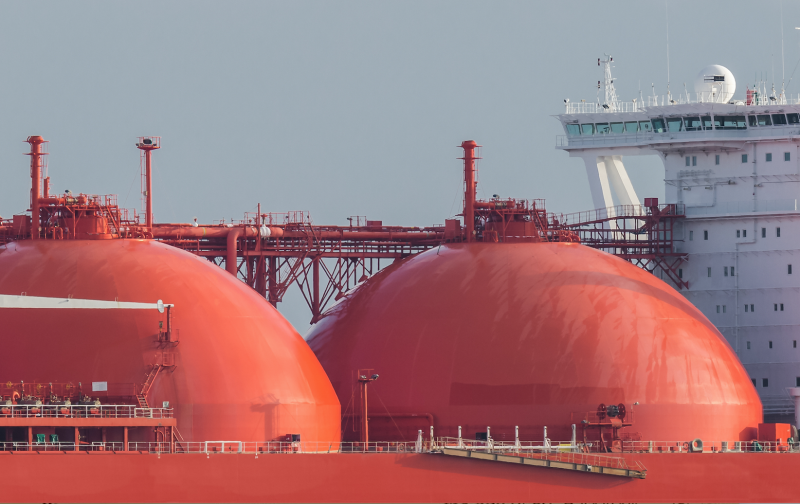China Petrochemical Corporation (Sinopec) has become partner No. 6 in Qatar’s North Field East (NFE) expansion, the first and so far, only Asian equity stakeholder to participate in what the industry regards as its largest project to date.
Qatar’s Energy Minister and President and CEO of QatarEnergy, Saad Sherida Al-Kaabi, signed the equity-participation agreement with Sinopec Chairman Ma Yong-sheng on 12 April in Doha. Under the agreement, Sinopec will hold a 5% interest in one of the NFE joint-venture companies that own the project, according to a QatarEnergy news release.
Sinopec’s stake is the equivalent of one NFE train with a capacity of 8 mpta and doesn’t affect the participating interests of any other shareholder, QatarEnergy said, while Sinopec clarified in its own release that its 5% joint-venture interest represents 1.25% of shares in the overall project.
Sinopec now joins a partnership structure announced in summer 2022 in which Shell holds a 6.25% of NFE shares overall, TotalEnergies (6.25%), Exxon (6.25%), Eni (3.12%), and ConocoPhillips (3.12%).
Phase 1 of the $28.75-billion NFE expansion envisions four new mega LNG trains with a combined nameplate capacity of 32 mpta to boost production initially by 43% to 110 mtpa from the current 77 mtpa. Two more trains will be added during Phase 2 (known as the North Field South) development to reach a final targeted production of 126 mtpa (up 64%) by 2027, according to QatarEnergy’s current plan.
Sinopec, QatarEnergy Scored First Goal at World Cup
Signing of the equity-participation agreement follows another first when QatarEnergy agreed to export 4 mtpa of LNG to Sinopec under a $60-billion, 27-year sales and purchase agreement (SPA), the longest, long-term SPA ever, signed in November during the 2022 World Cup in Doha.
In an analysis published on the Carnegie Endowment for International Peace website, Justin Dargin, a nonresident scholar in Carnegie’s Middle East Program, wrote, “Beijing has been meticulously building up its presence in the Gulf” with an eye to securing long-term energy security.
He explained, “… as the West and other regions transition from Russian hydrocarbons, Qatar is positioning itself as a long-term, stable energy exporter that will not allow geopolitical considerations to disrupt its supply. As a result, long-term engagement with Qatar fits well into China’s overall geostrategic aims in the MENA region as Russia becomes increasingly marginalized.”
Long-term, oil-indexed LNG supply contracts are “an essential method for buyers to insure the security of their supplies and for suppliers to maintain the security of demand,” Dargin concluded.

In its 2023 LNG Outlook, Shell noted that by 2030, 80% of new global LNG supply will be coming from Qatar and the US.
On the demand side, China is the world’s top LNG consumer and as such it continues to lead Asia’s LNG regasification capacity additions, accounting for 34% of the region’s total regasification capacity additions forecast for the period from 2021 to 2026, according to the data and analytics company GlobalData.
In a report published in November 2022 Global Data predicted that China will add 6,602 Bcf in regasification capacity by 2026.
Newbuild terminals will account for 5,123 Bcf of capacity growth, while the remainder will be generated by expanding existing regasification terminals.
In a news release, GlobalData analyst Himani Pant Pandey said that the planned Tangshan II terminal operated by Caofeidian Xintian LNG will contribute the most to China’s regasification capacity growth. The terminal was expected to start operations last year with a capacity of 341 Bcf, which is forecast to ramp up to 584 Bcf by 2026, Pandey said.
Another newbuild, Yantai I operated by Yantai LNG Group, is expected to add 487 Bcf of regasification capacity by 2026.
China’s expansion projects include the Qingdao Expansion II regasification terminal with 341 Bcf of capacity expected to be added in 2023, according to GlobalData.
India ranks second to China in adding regasification capacity. The newbuild Kakinada GBS (gravity-based structure) floating regasification unit operated by Crown LNG India would account for 350.6 Bcf of GlobalData’s 3,428 Bcf total Indian forecast for 2025.
Norway’s Crown LNG is developing the monsoon-proof GBS Kakinada 11 km off India’s east coast in the Bay of Bengal. Aker Solutions is delivering front-end engineering and design with subcontractors Siemens Energy and Wärtsilä Gas Solutions, according to Crown’s website.
India’s remaining growth would come from Shell’s Hazira Expansion (244 Bcf) and the planned Jaigarh Port Floating terminal (274 Bcf) operated by H-Energy Gateway Pvt. Ltd., according to GlobalData.


